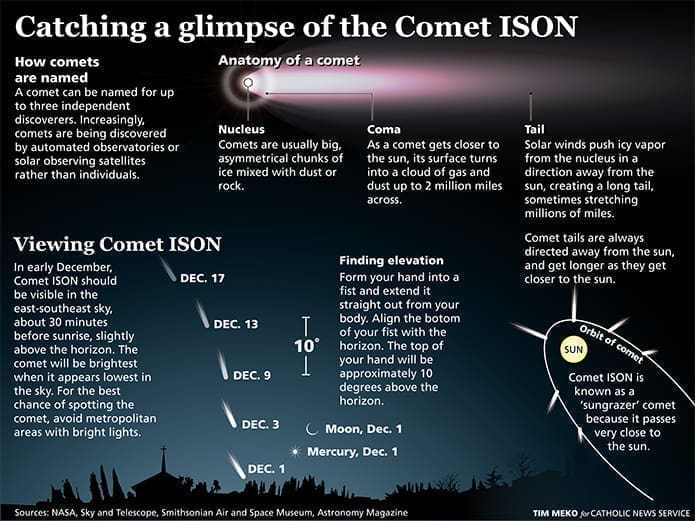
Washington
Comet ISON expected to give earth-based observers a Thanksgiving show
By DENNIS SADOWSKI, Catholic News Service | Published November 7, 2013
WASHINGTON (CNS)—A “dirty snowball” is expected to put on a show for earth-based observers in the pre-dawn skies around Thanksgiving.
Astronomers are projecting that Comet ISON, discovered in September 2012, will be a unusually bright visitor to the inner solar system starting just before Nov. 28 and continuing for days afterward.
But, as usual in the field of comet study, there is no certainty in knowing exactly how bright Comet ISON will become or how spectacular the show might be from this first-time visitor from the deepest reaches of the solar system.
“It could potentially be very, very bright if it doesn’t get ripped apart or fall into the sun,” said Edward Guinan, professor of astronomy and astrophysics at Villanova University in Pennsylvania. “You just never know these first-time comets what they’re going to do. Sometimes they fizzle.”
Even if Comet ISON does not become stunningly bright, anyone with an unobstructed view to the east-southeast—and clear skies, of course—should be able to easily spot it in the early morning twilight beginning around Nov. 22 and continuing for at least a couple of weeks.
“This should be well worth looking at as it comes on in,” said Scott Baird, professor of physics and astronomy at Benedictine College in Atchison, Kan. “It may not be as bright as Halley’s Comet or the moon, but for people interested in astronomy, it’s certainly worth getting out and looking at.”
Comet ISON is what astronomers call a sungrazer, meaning it will pass extremely close to the sun’s surface. In this case, ISON will glide through the solar atmosphere at less than 1 million miles from the star’s surface at perihelion, or its closest approach.
Because of its nearness to the sun, a sungrazer can throw off a lot of dust, gases and water vapor—hence the dirty snowball moniker—causing it to shine brighter than Venus. Occasionally, a sungrazer can be as bright as a full moon.
Or it can be much dimmer or break into smaller pieces.
“From early projections, it’s now two to three magnitudes fainter than they were hoping for,” Terry Flesch, adjunct professor in the physics department at Xavier University in Cincinnati, told Catholic News Service in early October. “But you never know. With a sungrazer you never know what’s going to happen when they reach perihelion. That’s the wild card.”
Special viewing sessions and student projects are planned at a number of Catholic colleges and universities as well as public observatories around the country. Check with them for details.
Flesch said the best way to view any comet is with the naked eye or with binoculars. He just advises getting away from city lights, which can wash out the comet’s appearance.
The view through a telescope will reveal the coma, the envelope of dust and sublimating gas that enshrouds the nucleus. Fine details of the comet’s tail may be visible, but usually appear only in photos.
Hope for a spectacular comet grew soon after Comet ISON was discovered far out in the solar system. Astronomers Vitali Nevski of Belarus and Artyom Novichonok of Russia, working for the International Scientific Optical Network, or ISON, found it while examining images taken just before morning twilight Sept. 21, 2012, in western Russia.
Karl Battams, astrophysicist and computational scientist at the U.S. Naval Observatory in Washington, told CNS that Comet ISON has garnered much interest from scientists because it likely originated in the Oort Cloud, a distant reservoir of icy bodies and leftover material from the time the solar system was formed.
“When a comet (passes so close to the sun) it’s subjected to a lot more radiation and heat then typical comets are exposed to. That means in addition to usual ices that melt from the comet, like water ice, we see a lot of vaporization and outgassing of elements that wouldn’t normally melt at lower temperatures,” explained Battams, who is part of the NASA Comet ISON Observing Campaign.
The comet will serve as a type of solar space probe, allowing astronomers to observe how the icy rock of primordial material interacts with the sun’s outer atmosphere and its magnetic field, he added.
Jesuit Father Jean-Baptiste Kikwaya, an astronomer with the Vatican Observatory, is among those carefully measuring the comet. He told CNS in an email Oct. 1 in the midst of a four-night run at the Vatican’s telescope on Mount Graham in southern Arizona that his observations are made to help determine the rotation rate and the color of the comet. Such measurements can help scientists determine whether the comet has a more metallic or a carbonaceous surface and if it might be more likely to break up because of the gravitational forces exerted by the sun.
Finder charts show that ISON should enter the constellation Virgo from Leo in November and follow a path southeastward as viewed from northern skies. At perihelion Nov. 28, the comet will be in Scorpius and take a dramatic swing to the north.
It’s at perihelion that ISON is expected to be at its brightest. If it gets as showy as hoped, the comet could be visible during the day. Battams urged observers going out after their Thanksgiving dinner to take necessary precautions to avoid looking directly at the sun, especially if they are using any optical aid, because of the risk of blindness.
After its close encounter with the sun, it is expected that ISON will fade rapidly, but maintain naked eye visibility through December and early January as it passes through the constellations Ophiuchus, Serpens, Hercules and Corona Borealis. It will offer a fine naked-eye pairing at the end of the first week of January as it passes near Polaris, the North Star. Comet ISON should be visible in binoculars and telescopes for several more weeks in 2014.